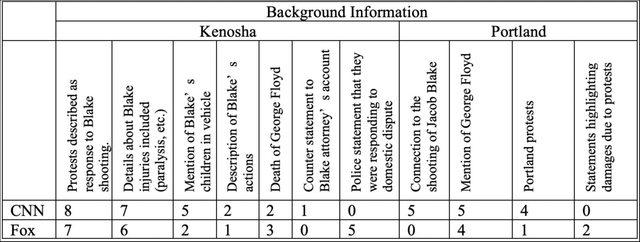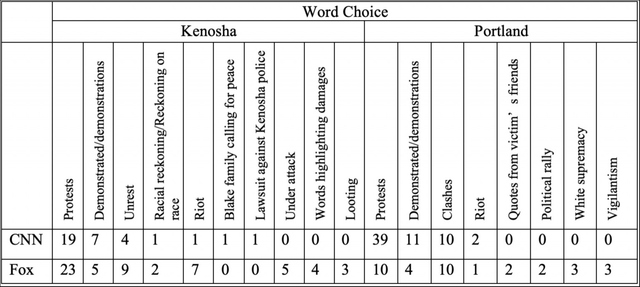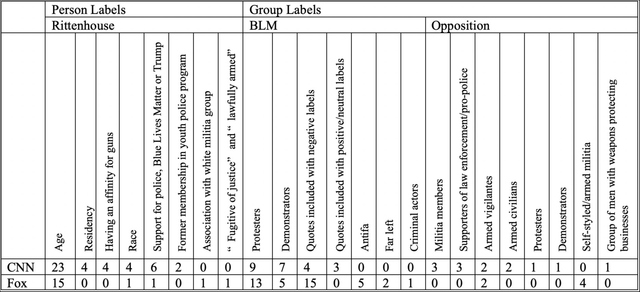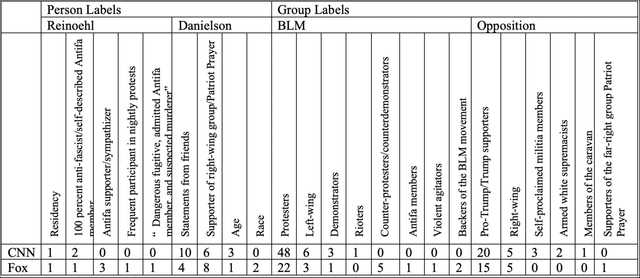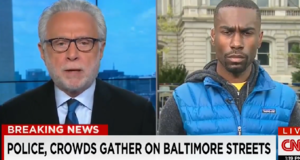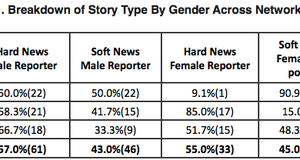Biased Narratives in the Media: Coverage of Fatal Shootings During Black Lives Matter Demonstrations
By
2022, Vol. 14 No. 04 | pg. 1/1
IN THIS ARTICLE
KEYWORDS
AbstractDuring the summer of 2020, two fatal shootings occurred following Black Lives Matter protests. The first event involved Kyle Rittenhouse in Kenosha, Wisconsin, and the second Michael Reinoehl in Portland, Oregon. Two shootings, each committed by members of opposing political ideologies and opposite their victims, present an opportunity to check for ideological bias in the news by comparing CNN and Fox coverage, sources who lean opposite on media bias scales, in the immediate aftermath of fatal shootings. Results suggest that CNN relied more heavily on episodic framing of the Portland event, thereby lifting some blame from Reinoehl, while doing the opposite for the Kenosha event, thereby placing more blame on Rittenhouse. Similarly, Fox news relied more on a thematic frame surrounding violence occurring during BLM protests, most notably in Portland, where a BLM protester fatally shot a counter-protester. The presence of bias in each case underscores the value of a diverse media diet, and the need to rely on sources that challenge rather than reinforce one’s own biases. IntroductionThe Black Lives Matter (BLM) Movement began as a social media hashtag during the summer of 2013, after George Zimmerman was shielded by Florida's "stand your ground" law and acquitted for the fatal shooting of Trayvon Martin. The movement has gained momentum with widely distributed cell phone recordings of police violence against people of color. In the summer of 2020, the death of George Floyd, beneath the knee of Minneapolis police officer Derek Chauvin, sparked demonstrations. Just months later, in Kenosha, WI, police officers shot and paralyzed Jacob Blake and more demonstrations erupted alongside persistent protests. On August 25th, counter protester Kyle Rittenhouse of Antioch, IL shot three protesters demonstrating in Kenosha. On August 29th, protester Michael Reinoehl shot counter protester Aaron Danielson during demonstrations in Portland. These shootings occurred within days of each other amid BLM demonstrations over the shooting of George Floyd and Jacob Blake. Given these similar but inverted circumstantial variables, researchers have an opportunity to check for ideological bias by comparing media coverage in the immediate aftermath of each event. Related research has shown that news outlets exhibit ideological bias through the use of narrative framing (Hamborg et al., 2018). Frames work indirectly to support prior beliefs and shared assumptions. As humans, we rely on framing to decide which events are meaningful and worth our attention; we are “not told what to think, but rather what to think about it” (Lane et al., 2020). Studies have analyzed how narrative frames represent actors involved in an event and how frames shape audience perceptions of events (Stone and Socia, 2017; Duxbury et al., 2018). News sources frequently present the information they decide is most salient and representative of the narrative (Banks, 2018; Hamborg et al., 2018). Recent research has observed a variance between perpetrators’ characteristics or associations and media reports about them (Colburn and Melander, 2018). During the BLM movement, informational details about the movement have been framed differently (Lane et al. 2020), depending on who acts violently and who is the target of that violence.The work of Lane et al. suggests that frames found in reporting political topics can be sorted into two overarching categories: episodic and thematic (2020). Episodic frames represent events as isolated and anomalous, disconnected from a larger context. Thematic frames, on the other hand, represent events as connected to a bigger picture and larger context (Lane et al., 2020). Following the death of Trayvon Martin, news coverage of BLM incidents used negative labels (unlawful assembly, disorderly conduct, charges of trespassing, targeting police officers, and outside agitation) that contributed to an episodic frame or narrative of a movement erupting in episodic violence, disconnected from a long history of racial oppression (Lane et al., 2020). Given the public’s easy access to and heavy reliance on online news outlets (Duxbury et al., 2018), we must be alert to the way select details emphasize salient features that may influence audience interpretation of the facts (Stone and Socia, 2017). Bias isn’t always intentional but recognizing it can empower news consumers to filter bias and to cross-check multiple news sources. While various types of media bias exist, this research will focus on ideological bias, the bias that occurs when a news outlet pushes a certain opinion or frame on the news they are reporting (Hamborg et al., 2018). Journalists must select some details over others, and their language choices have the potential to shape or to distort readers’ perceptions of reality. Though reporters strive to limit bias, especially in news reporting, it remains an impossibility (Duxbury et al., 2018). Word connotations alone may influence readers' interpretation of events and issues and encourage them toward particular actions. Such influence is frequently seen in reporting on political issues, which shapes readers' initial perceptions and may influence political decisions (Hamborg et al., 2018). In the rhetoric used in media coverage, common frames depict the BLM as anti-police and demonstrations as violent (Banks, 2018). Repeated attention to violent or unlawful acts committed by supporters of BLM renders those details salient and establishes a frame through which other details are viewed, a frame that depicts the movement as unlawful and violent (Banks, 2018). While narrative frames may not directly change the views of readers, readers who consistently rely on single news sources risk falling into an echo chamber, where their prior beliefs and shared assumptions are reinforced (Duxbury et al., 2018). To better understand how the news structures salience and interpretation, this study analyzes two news outlets' reports on two specific events: the shootings in Kenosha, WI and in Portland, OR. The research will identify and analyze significant language patterns used to represent and depict perpetrators and their actions at each event. MethodologyThe immediate aftermath of an event is an important time in reporting because it comes closer to the origin of a rhetorical situation while audience awareness is still forming and before key terms, concepts, and opinions are set (Bitzer, 1968). After an event has occurred, those seeking information will have to rely on the limited news coverage available to them. In many cases, readers will only scan headlines to get a sense of an event. How the information is presented will likely impact the audience’s perception, with the framed information being the first to influence their understanding of the event (Stone and Socia, 2017). The media bias chart used to guide the research for this paper comes from AllSides. This source categorizes the major news networks’ political leanings on a scale of “left, lean left, center, lean right, right” by using multiple methods of calculation, including blind bias surveys, editorial reviews, third party analysis, community feedback, and an independent review performed by AllSides. Articles gathered for the sample collection came directly from the online news outlets Fox and CNN. By selecting two news outlets with opposing ideologies, with CNN (news only) leaning left, and Fox (online news only) leaning right (AllSides), we will be able to test for framing and ideological bias in reporting on events connected to BLM demonstrations (Banks, 2018). Ten articles were collected from CNN and Fox News websites posted within a seven-day window of each event, for a total of 20 articles from each news service (Duxbury et al., 2018; Potterf and Pohl, 2018). For the Kenosha shooting, articles published between August 25, 2020, and September 2, 2020, were examined. For the Portland shooting, articles published between August 29, 2020, and September 5, 2020, were examined (with the exception of the CNN Portland coverage, in which an extra day was added to complete the corpus). To gather articles for the CNN data sets, only the city names were used in the search. Beginning with the first articles published during their respective time frames, the first ten articles specifically discussing either the perpetrator or the event itself were collected. Using this same method did not work for the Fox website. When searching just the city name, significantly more articles came up (2,000+). Because of this, when sampling articles for the Fox data sets, additional limiting search terms were used. For the Kenosha data set, “Kenosha Kyle Rittenhouse” was used as the search term because he was named as a suspect fairly early, and so articles discussing him appeared at the beginning of the time frame. For the Portland data set, “Portland protest” was used. Because Reinoehl was not mentioned as a suspect until the end of the time frame, Reinoehl’s name was not included in the search. Since there were so many results on the Fox searches, date filters were set so that it would only display articles published on each date, one date at a time. This was done to help keep the results manageable and make sure that sampling was coming from all the articles, not just the select few that appeared at the front of the results. VariablesOnce the corpus was established, each article was examined for variables that might provide evidence of bias. Following the lead of Hamborg et al. (2018), the study sought to identify meaningful patterns in the following categories that would serve to sort evidence of bias in the selection of salient facts: event background, salient facts, labels, word choice, and headlines. FindingsResults will be organized comparatively first by event and then by actor to better identify patterns in framing. Event: KenoshaTable 1. Background information given for both the Kenosha and Portland events and the rate at which they appeared across articles. Although CNN articles offered scant details on BLM as a movement (its origins and goals), articles twice alluded to the death of George Floyd, and several provided a number of details on the police shooting of Jacob Blake. A large majority of the CNN articles described the protests as a direct response to the police shooting of Blake, with explicit details about the number and location of shots; the consequences of injury (hospitalization and waist-down paralysis); and the fact that Blake’s children were in the car when police fired multiple shots. CNN included descriptions of the actions taken by Blake and the statements made by Blake’s attorney twice, saying that he was trying to break up an argument when he was shot by police. Only once did CNN include a counter statement to the attorney’s claim, and while doing so included the statements from Blake’s family, his lawyer, and a witness, who all refuted the police account. While Fox also offered limited details surrounding the BLM movement and George Floyd, they increasingly discussed the events surrounding the Jacob Blake shooting. The majority of articles described the protests as a response to the Blake shooting, making many references to the consequences of his injuries (hospitalization and waist-down paralysis). Half of the articles emphasized the statement from police saying they were responding to a domestic dispute before officers shot Blake, and two Fox articles note that Blake’s children were in the vehicle at the time of the shooting. Table 2. Information given on the actual events that transpired in both Kenosha and Portland and how frequently it appeared across articles. In the CNN articles, information given on protests were largely dependent on statements given by police. Of the statements included, two from Kenosha County Sheriff Beth appeared across the articles one time each. These quotes included a description of the clashes occurring between police and protesters and the sheriff’s claim that the shooting may not have happened if Rittenhouse and demonstrators were not on the street after curfew. CNN articles highlighted co-occurring events that were not directly connected to the Rittenhouse shooting. Twice they reported that Wisconsin’s governor declared a state of emergency, causing members of the National Guard to come support the city of Kenosha, and that crowds had caused damage to dozens of buildings and set more than thirty fires. Fox articles highlighted this state of emergency as well, with half the articles discussing the Governor’s call for the National Guard to assist Kenosha. A couple of the articles stated that crowds had destroyed dozens of buildings and set more than thirty fires in the city’s downtown. Table 3. Word choice surrounding each event for both Kenosha and Portland and the frequency in which they appeared throughout the articles. When describing the incident on the night Rittenhouse came to Kenosha, CNN used the word protest overwhelmingly when identifying the event, at a rate of almost two times per article. Words such as demonstrated/demonstrations appeared in a large majority of the articles and unrest appeared in nearly half. The Fox articles used protests to describe the events just over twice per article. The second most common labels associated with the events included words such as unrest, riots, under attack, and demonstrations, which all appeared in over half the articles. The words destroyed or damaged were used to discuss the state of the city in four separate articles, while accompanying words such as looting and reckoning on race appeared only a few times but were repeated. Event: PortlandCNN articles reported that events unfolding in Portland were connected to the shooting of Jacob Blake, and that protests had begun initially in response to the killing of George Floyd. Statements describing connections to Blake and Floyd appeared in half the articles. Just under half the articles emphasized the duration of the protests in Portland. While Fox’s articles did not mention the shooting of Jacob Blake, nearly half the articles called attention to the background information surrounding events connected to BLM, specifically how people in Portland had been protesting since the death of George Floyd. In addition to background information, reporter statements highlighted twice per article the vandalism and violence taking place during these demonstrations. The Portland event had a fair number of background events that occurred before the shooting. CNN articles focused heavily on the actions of each group as protesters and caravanners clashed. CNN articles frequently included information on the protests and protesters, with a focus on the facts surrounding police arrests of those “attacking property” or “throwing items at police.” CNN also focused on the arrival of local law enforcement agencies from outside of Portland who were coming to assist in the unrest, and thus increased troopers and US Marshals capacity to arrest and prosecute suspects. Additionally, CNN focused on the fact that protesters came prepared, wearing heavy protective gear while confronting police. Finally, CNN focused on the fact that the gun violence had escalated in Portland, resulting in 911 calls going unanswered. Fox articles spent time focusing primarily on the interactions between the caravanners and protesters. However, this information was not repeated as frequently as it was in CNN articles, with accounts of the violence only appearing twice in the Fox articles. Fox articles also foregrounded information on the protesters and their actions throughout the city, focusing largely on violent actions. Articles reported the statement from the attorney’s office that they planned to begin prosecuting offenses such as arson and physical violence, and they included details about the protesters’ combative actions against police and heightening friction between the two groups. When reporting on the shooting committed by Reinoehl, CNN included a statement from the president of the Portland Police Association discounting the relevance of his “race, political affiliation, or where he was from.” This statement continued to describe the destruction the protests had caused. Overall, when describing the event as a whole, articles used the word protests extensively, almost four times in each article. Other words used often included demonstrated/demonstrations, clashes, and riot. While describing the events, Fox articles placed their focus on the victim and provided more impact statements made from the victim’s friends and loved ones who expressed their feelings of loss for Danielson. The most frequent words used to describe the events that transpired in Portland are tied between clashes and protests, which appear equally in every article. Other common descriptors included demonstrating/demonstrations, political rally, and riots. Actor: Rittenhouse in KenoshaThe fact pattern in the CNN articles focused on the actions of the shooter, Kyle Rittenhouse, and the charges brought against him. Nearly all articles mention the charge of first-degree intentional homicide, and over half include the charge of attempted homicide and count of reckless homicide. Other counts, such as recklessly endangering safety and possession of a dangerous weapon, appeared two times. Included in half of the articles is Rittenhouse's attorneys’ statements that the shooting was an act of self-defense. The video footage of Rittenhouse firing his gun appeared in several articles, as well as the fact that despite carrying his gun, he was able to run toward police without them stopping him. Fox alludes the most to charges of intentional first-degree homicide brought against Rittenhouse, with charges appearing in over half of the Fox articles while his one count of possession of a dangerous weapon appeared twice. Statements from his attorneys claiming self-defense appeared in half the articles. One of these statements came from John Pierce, who said that he didn’t believe the investigation was serious, and that Rittenhouse was being targeted because of his conservative viewpoints. This emphasis on charges parallels the article’s reference to court records that described Rittenhouse as a “fugitive of justice” who “fled the state of Wisconsin with the intent to avoid prosecution.” However, each of these statements only appeared once. Included in both the CNN and Fox articles are facts on Rittenhouse’s interactions with victims, but these do not appear frequently. Information provided on victims largely focused on a primary victim, Rosenbaum, but still remained very limited and only in relation to the actions committed by Rittenhouse. The articles did not include many facts surrounding the other two victims, and the only information given came from a criminal complaint. Table 4. Labels used by each source to describe the different actors in the Kenosha event and how frequently they appeared. The labels used by CNN drew specific attention to Rittenhouse’s legal status as a minor: 17-year-old, teen/teenager, and young man accounted for half of all the labels used to describe him. Descriptions surrounding his residency, “affinity for guns,” and race each appear in a third of the articles, and his support of “Blue Lives Matter,” President Donald Trump, and his former membership in a youth police cadet program appeared only a couple of times each. Fox articles also highlighted Rittenhouse’s age as a defining factor, with 17-year-old, teenager/teenage, juvenile, and young, white male accounting for nearly all of the labels used throughout the articles. Apart from his age, mentions of his association with a white militia group, pro-police beliefs, and quotes calling him a “fugitive of justice” and “a peaceful protester, lawfully armed,” appear only once each. When discussing the BLM group, CNN used labels such as protesters and demonstrators almost every time. Some outliers that appeared only once came primarily from quoted sources, but included labels such as thugs, bad people, troublemakers, violent anarchists, peaceful protesters, peaceful demonstrators, and “those who message the police oppose.” In the Fox articles’ discussion on the BLM group, reporters used protesters more often than any other label. Labels such as rioters, mob, Antifa, and demonstrators were used five times each throughout the ten articles. Words such as far-left, violent, looters, thugs, anarchists, and criminal actors appeared infrequently but were present. When describing counter groups, CNN’s articles used labels such as militia members and armed civilians the most. Other labels or descriptions that appeared included a “group of men with weapons who were protecting businesses,” supporters of law enforcement, pro-police demonstrators, pro-police protesters, and “those who message the police support.” When discussing counter groups, Fox described them as self-styled militias, armed vigilantes, and armed militia, each only twice. Actor: Reinoehl in PortlandIn Portland, CNN gave information specifically about Reinoehl’s personal life, primarily focusing on his political beliefs, which showed hatred toward President Trump, as can be evidenced from statements either quoted directly by Reinoehl or pulled from his social media pages. Previous criminal activity for which he was charged was also included throughout the articles. CNN included little information of his death, mentioning only twice throughout the articles that he was shot while officers attempted to arrest him, and that he was threatening law enforcement with a gun, which resulted in his death. Fox articles highlighted the actions of Reinoehl, particularly his standoff with police and his shooting of Danielson, each appearing in over half the articles. This fact pattern continued with nearly half the articles reporting on past charges against Reinoehl for resisting arrest during protests that turned violent. Fact patterns surrounding the shooting in the CNN articles paid close attention to those who were mourning Danielson, his connection to the group Patriot Prayer, and his death at the scene of the shooting. Similarly, Fox articles did not focus heavily on Reinoehl’s actions on the night of the shooting. When providing salient information for that night, Fox reporters most often discussed how Danielson died; how he was killed after Portland protesters clashed with Trump supporters; how Danielson was a part of the right-wing group Patriot Prayer; and how police were able to locate the scene of the shooting from the sounds of gunfire. Table 5. Labels used by each source to describe the different actors in the Portland event and how frequently they appeared. Labels used by CNN to describe Reinoehl focus only on his residency and his affiliation with Antifa, which was only mentioned twice. Fox discussed Reinoehl more often, and almost always regarding his affiliation with Antifa and other left-wing groups and events. In reports on Danielson, CNN articles relied primarily on statements from his friends that included labels. Statements from the victim’s close friend Luke Carrillo described Danielson as “quick-witted and very funny…” Carillo defended Danielson as not a radical, racist, or fascist, and emphasized Danielson’s love for his country and Portland. Apart from the descriptions included from friends, CNN labeled Danielson primarily by his political associations, as a supporter of a right-wing group. Fox articles didn’t rely as heavily on the statements of friends but did include parts of these statements that described Danielson as “a good friend.” Primarily, Fox articles included the victim’s political affiliations above all other labels, stating that he was a supporter of Patriot Prayer. When referring to the BLM group, the articles from CNN used the word protesters extensively, with the label appearing over four times in each of the ten articles. Followed by this, words such as left-wing were part of the narrative, with occasional use of demonstrators and rioters. Fox articles also used protesters most frequently to describe the BLM group, with the word appearing about twice per article. Words such as counter-protesters, left-wing, counter demonstrators, demonstrators, Antifa members, and violent agitators were also used routinely. CNN described the opposing group as (Pro-)Trump supporters more than any other label. Other labels used heavily emphasized their political beliefs, such as right-wing, self-proclaimed militia members, armed white supremacists, and members of the caravan. Fox placed heavy emphasis on the political affiliations when labeling the opposing group, calling them Pro-Trump or Trump supporters most frequently, followed by labels such as right-wing and “supporters of far-right Patriot Prayer group.” Article HeadlinesThe headlines for the articles sampled are provided below. The total number of violent words were divided by the total word count to find the percentage of violent words used (words counted as violent are italicized in the list below). Kenosha HeadlinesFor the Kenosha coverage, words with violent connotation made up approximately 10.1 percent of CNN’s headlines and approximately 11.8 percent in Fox headlines. CNN 10.1% violent words:
Fox 11.8% violent words:
Portland HeadlinesFor the Portland coverage, words with violent connotation made up approximately 10.7 percent of CNN’s headlines and approximately 15.9 percent of Fox headlines. CNN 10.7% violent words:
Fox 15.9% violent words:
DiscussionEvent--persistent theme or singular episodes?KenoshaWhen giving background information for the event that occurred in Kenosha, neither of the news sources contributed much as a whole. What background CNN did contribute most frequently focused on Blake personally, including his injuries and his children. Fox likewise focused on Blake and his injuries but also highlighted that those injuries occurred during a domestic abuse call—a fact CNN did not mention. CNN’s more exclusive focus on injuries Blake suffered and the trauma his children experienced positions Blake and his family as victims in a way that invokes a sympathetic response more likely to warrant or justify the ensuing protests. While Fox’s coverage also highlights Blake’s injuries, the contextual detail about a domestic violence call is more likely to encourage readers to identify with the police perception that Blake might be a perpetrator, invoking a sympathetic response more likely to warrant or justify the use of force. Both sources paid fairly equal attention to the conflict that had occurred between demonstrators and counterdemonstrators. CNN’s focus on the destructive actions of protesters and the breach of curfew as a contributing cause distributed responsibility for the fatal shooting on the victims and Rittenhouse equally. Both CNN and Fox sources discussed the overarching events taking place in the city at the time, each pointing to the call to bring in members of the National Guard to help control the unrest. The main difference here is that Fox reports more frequently described destructive crowds and the need for military backup, creating a more violent frame around the actions of protesters. CNN and Fox both used the word protests to describe the events more than any other word. The use of words containing a negative connotation, such as unrest and riot were used more frequently by Fox than they were in the CNN articles. Another difference is that Fox used charged words or phrases such as under attack, looting, or damages, while CNN did not. By including more violent words, Fox articles supported a thematic frame that characterized events by violence attributed more broadly to the BLM protests themselves. CNN’s choice of words remained fairly neutral, supporting a more episodic frame that limited the scope of violence to particular events, without attributing it more broadly to the BLM movement. While CNN and Fox news sources both called for action and justice, Fox’s thematic frame attributed acts of violence to a larger scene or context, while CNN’s episodic frame tends to narrow the focus to racially motivated violence. PortlandBackground information given when reporting on the event in Portland was scarce for both sources. CNN focused on the Blake and Floyd shootings equally, while abstaining from mentioning the damages caused in protests preceding the event that was being covered. This presents a frame from CNN that follows a more episodic approach, which may be attributed to the fact that a member of the BLM group, a group CNN leans more sympathetic towards, was the perpetrator in the crimes. By putting distance between the BLM movement and the fatal shooting of a counter protestor, CNN’s frame minimizes causal connections between protests, property damage, and violence without needing to blame or justify. Fox skipped mention of the Blake incident and touched lightly on the Floyd shooting. By focusing on the damages due to nightly and violent BLM protests in Portland, leading up to the fatal shooting, Fox provides a thematic lens that characterizes the shooting as one more act of violence arising from the movement. Both CNN and Fox highlighted interactions between members of the Pro-Trump caravan and BLM protesters, but CNN included more information more often. Fox didn’t focus as much on information, but did include that violent interactions had occurred, portraying violence in general without a causal connection to the pro-Trump caravan. CNN’s portrayal of violence from both sides and Fox’s emphasis on property damages in general, reveals a meaningful difference between an episodic frame that portrays explicit violence between named parties and a thematic frame that creates an aura of ongoing violence. In the episodic frame, violence is attributed to provocative counter protestors. In the thematic frame, violence is attributed to a protest movement. The two news sources did not choose words consistently in their reporting on the event in Portland. CNN used the word protests at an overwhelmingly higher rate than Fox did, while Fox used protests equally with demonstrations. The word protest holds a much more positive connotation because it is a reaction to something, in this case to the police use of excessive force. The more neutral term demonstrations (or negative labels such as riots) are less likely to justify retaliatory acts of violence and more likely to frame the BLM movement as inherently violent. ActorKenosha: Rittenhouse and VictimsBoth CNN and Fox primarily focused on presenting the charges made against Rittenhouse, with both sources including statements by Rittenhouse’s attorneys claiming that he had acted in self-defense. The main difference is that CNN included the self-defense statements half the time when they mentioned the charges, while Fox included the self-defense argument and the charges equally. By emphasizing the charges more than the defense argument, CNN might encourage readers to come to judgment on the charges without considering the defense. Neither of the sources included much information on the victims, with both sources only giving about one or two statements surrounding the victims specifically. CNN articles emphasized the victims’ lack of violence, and Rittenhouse’s response to the shootings with statements like “I just killed somebody.” This helps support the narrative that the victims, BLM supporters, were unrightfully killed in a thematic occurrence of violence from counter-protesters. In the Fox articles, violent interactions that took place between Rittenhouse and the victims were highlighted much more frequently and helped shape a frame that supports a narrative that Rittenhouse acted in self-defense. When it came to the victims, they were characterized strictly by their interactions with Rittenhouse. Compared to the Portland data, information on the victims of the shooting wasn’t seen as salient to the story. Overall, Fox placing focus on specific interactions with victims lends a more sympathetic response to Rittenhouse and shapes his actions into ones that can be seen as justifiable. CNN chose to leave these interactions out which helps support the narrative of BLM protesters being peaceful, with counter-protesters serving as the sole agitators. When labeling Rittenhouse, both CNN and Fox most often characterized him by age, emphasizing him as a minor. By repeating his age, news coverage reminded readers that he is young, possibly earning him more sympathy for his actions. Both sources also included that Rittenhouse supported police and was a part of a “white militia group”; however, those terms were not used frequently in the Fox articles and used interchangeably throughout the CNN coverage. CNN’s frequent use of these labels ties Rittenhouse to his political beliefs and helps to enforce the thematic frame that right-wing members or groups act violently and opposite of the BLM movement. Fox’s decision to not use these labels as frequently helps to steer readers into seeing Rittenhouse’s actions as an episodic act, and not one on behalf of the groups mentioned more heavily in the CNN articles. Both sources used protesters to describe the BLM group more than any other label. Labels taken from quotes that were included in the CNN articles primarily carried a negative connotation but were only used once each, while the quoted labels with negative connotations cited in the Fox articles were used repeatedly, with many being used five times each throughout the ten articles. Other words that were used infrequently, but still appeared in the Fox article specifically had a very violent and negative connotation toward them. Though both sources included labels that negatively frame the BLM group, Fox’s increased repetition of these negative labels shows how Fox is able to enforce a negative perception of the group as a whole. While describing counter groups, CNN included two primary labels, militia members and armed civilians. Other labels used did not appear as much, but each one supported the idea that the group was protecting businesses and supportive of police action. Fox’s description of these groups was scarce, though the few labels they were given each contained a negative connotation. Though CNN’s labels of counter groups aren't inherently negative, CNN has an established narrative throughout their coverage that those in support of police action have been the primary agitators during protests, which adds more weight to the seemingly neutral labels used. Portland: Reinoehl and DanielsonWhen repeating the salient facts surrounding Reinoehl, CNN spent less time discussing his prior offenses and more on his actions during this particular event while Fox included extensive coverage of Reinoehl’s past offenses, violence toward law enforcement, and affiliation with the left-wing groups. Fox’s focus on his past presents a thematic framework not only for Reinoehl himself, but for what he was thought to represent as well. CNN chose to focus on him as a perpetrator in only this single event, creating a frame that this could be out of character and his past doesn’t matter, which helps to take focus away from his party affiliations. These fact patterns reveal bias for both Fox and CNN as each source’s political ideology reinforces opposing narrative frames around the same person. As far as discussion around Danielson, CNN highlighted his affiliation with far-right groups such as Patriot Prayer while Fox did not. By presenting this information repeatedly, CNN worked to do what Fox was trying to do with Reinoehl and place a thematic frame on the opposite person, suggesting that whatever group they were affiliated with had a role in the violence that unfolded. Due to a possible lack of coverage on Reinoehl, neither of the sources focused specifically on him that heavily. When they did discuss him, both sources focused directly on personal statements he had made. The difference here is that CNN focused on aspects of his statements that focused more on where he was from and general beliefs, whereas Fox highlighted the parts of the statements that connected him with Antifa and included his participation in the violent protests. CNN’s focus on who Reinoehl was outside of his beliefs helps to personify him and detach him from the larger movement, serving as a way to distance his violent actions from the BLM movement itself. Fox’s emphasis on Reinoehl’s violent past and connection with left-wing groups helps shape a thematic frame that members of left-wing groups act in violence. Labels commonly used for Danielson largely came in the forms of quoted statements made by his friends and other members of Patriot Prayer. When including these statements, CNN didn’t place any specific emphasis while Fox emphasized his affiliation and support for Patriot Prayer. This emphasis by Fox helps to connect the sympathy felt for Danielson, a victim of gun violence, to Patriot Prayer, who CNN has framed as a violent group who was at fault for the violent actions that took place. When labeling the BLM group, both sources used protesters the most. The use of protester versus counter-protester was difficult to attribute to certain groups though, given that there appeared to be a discrepancy surrounding which group was the protagonist and which was the antagonist. CNN never used counter-protesters to describe the BLM group, though Fox did. This suggests that CNN felt the BLM group was not responding to another groups’ protest, rather they were protesting against those who took the opposing side. As far as political associations, CNN placed the BLM group with liberal ideologies and groups while Fox placed emphasis on BLM being associated with Antifa and other violent groups or events. When labeling the members of the caravan, both sources used Pro-Trump or Trump supporters equally. Right-wing was used by each source in about half of their articles as well, showing there was a fairly equal framework being placed in that aspect by each source. The primary differences were found in Fox calling the group “supporters of Patriot Prayer” (though only once), and CNN referring to them as “self-proclaimed militia members” and “armed white supremacists” a few times each. These certainly hold a stark difference with one another, with CNN framing the group in a more negative light than they did when discussing the BLM group, despite a member of the BLM group drawing attention to the event in the first place. Creating a frame that places blame more on the members of the caravan can cause the audience to feel more sympathetic towards the BLM group and believe they were the ones attacked. Word choice surrounding Reinoehl was scarce since he was not named a suspect until later in the timeline, and when discussing him the only quotes really came from his own statements. One particular quote is repeated by both sources where Reinoehl blatantly states he is a part of Antifa, though this statement was featured by Fox repeatedly, and by CNN only once, and equally with his other quotes surrounding police and government in general. Fox focusing on the quote specifically shows that he is a part of a larger whole, supporting the thematic framing, while CNN works to include that quote as only one of the many things he has said about the government, discrediting the importance of that quote in particular and isolating him from Antifa specifically. Article HeadlinesThe average percentage in the number of violent words used in article headlines can be attributed to the news sources’ use of “clickbait” or words meant to generate more views and clicks on their articles. However, there is a significant jump when comparing the rates in the Portland coverage. The percentages for CNN varied slightly between each event’s coverage, though with Fox there is an increase in the inclusion of violent words in headlines when comparing their coverage of Kenosha to Portland, with Portland being written as the more deadly and violent event. This can be attributed to the Portland victim being a member of a right-wing group, and the perpetrator being a member of the opposition. By including more violence, it draws the perpetrator as a violent actor who is representative of the BLM group. This could suggest that Fox shows a more sympathetic view toward Trump supporters, while holding a more critical view of the BLM group. ConclusionThis study suggests that, depending on the primary ideology of a news outlet, the content produced will likely frame details in a way that reinforces sympathy or judgment in relation to actors and events. While the two news outlets exhibit differences in the way they characterize events and actors, one thing remains the same—each adheres to that source’s ideological bias. This study has shown that there is media bias coming from all sides and reinforces the need for viewers to diversify where they receive their information. It is important to recognize the ways in which news outlets can influence perspective on an event or situation, and by doing so, viewers are able to grasp a better understanding of what actually happened in cities far from where they live and what is being presented to fit a narrative frame. Going forward, there is much room to research ways in which other sources and types of information are skewed by ideological bias. This study does not investigate readers’ perceptions and reactions to various frames, but the inquiry would be complemented by further research that tests specific frames more directly with audiences, particularly audiences segmented according to their reading habits and news diet. AcknowledgmentsI would like to express my deepest appreciation and gratitude to my faculty advisor, Dr. Jacqueline Cason, for her continuous support and guidance throughout the entirety of this project. References“Media Bias Chart.” AllSides, Version 2, https://www.allsides.com/media-bias/media-bias-ratings. Banks, Chloe. “Disciplining Black activism: post-racial rhetoric, public memory and decorum in news media framing of the Black Lives Matter movement.” Journal of Media & Cultural Studies, vol. 32, no. 6, 2018, pp. 709-720, doi: 10.1080/10304312.2018.1525920. Bitzer, Lloyd F. “The Rhetorical Situation.” Philosophy & Rhetoric, vol. 1, no. 1, 1968, pp. 1–14, JSTOR, www.jstor.org/stable/40236733. Colburn, Alayna, and Lisa A. Melander. “Beyond Black and White: An Analysis of Newspaper Representations of Alleged Criminal Offenders Based on Race and Ethnicity.” Journal of Contemporary Criminal Justice, vol. 34, no. 4, Nov. 2018, pp. 383–398, doi: 10.1177/1043986218787730. Duxbury, Scott W., et al. “Mental Illness, the Media, and the Moral Politics of Mass Violence: The Role of Race in Mass Shootings Coverage.” Journal of Research in Crime and Delinquency, vol. 55, no. 6, Nov. 2018, pp. 766–797, doi: 10.1177/0022427818787225. Hamborg, Felix, Karsten Donnay, and Bela Gipp. "Automated identification of media bias in news articles: an interdisciplinary literature review." International Journal on Digital Libraries, vol. 20, no. 4, 2018, pp. 391-415. Lane, Kimberly, et al. “The Framing of Race: Trayvon Martin and the Black Lives Matter Movement.” Journal of Black Studies, vol. 51, no. 8, 2020, pp. 790-812., doi: 10.1177/0021934720946802 Potterf, Jebadiha E., and Jason R. Pohl. “A Black Teen, a White Cop, and a City in Turmoil: Analyzing Newspaper Reports on Ferguson, Missouri and the Death of Michael Brown.” Journal of Contemporary Criminal Justice, vol. 34, no. 4, Nov. 2018, pp. 421–441, doi: 10.1177/1043986218787732. Stone, Rebecca, and Kelly M. Socia. “Boy With Toy or Black Male with Gun: An Analysis of Online News Articles Covering the Shooting of Tamir Rice.” Race and Justice, vol. 9, no. 3, 2017, pp. 330–358., doi: 10.1177/2153368716689594. Suggested Reading from Inquiries Journal
Inquiries Journal provides undergraduate and graduate students around the world a platform for the wide dissemination of academic work over a range of core disciplines. Representing the work of students from hundreds of institutions around the globe, Inquiries Journal's large database of academic articles is completely free. Learn more | Blog | Submit Latest in Political Science |

